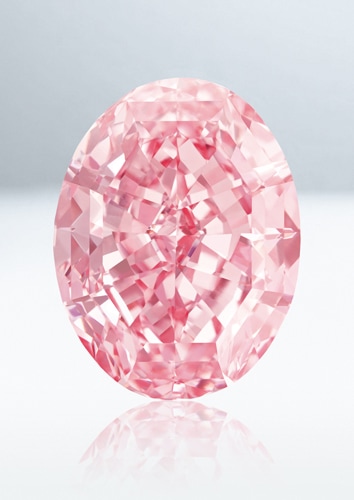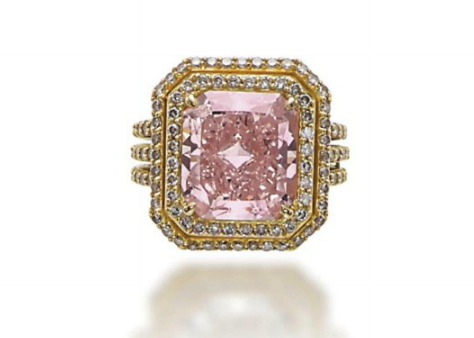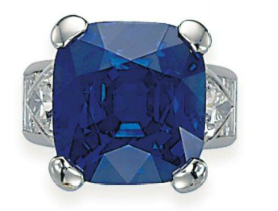The mysterious 6.16 Fancy Dark gray-blue Farnese Blue diamond, graded by GIA, will be auctioned by Sotheby’s May 15 in Geneva. Mined at Golcanda, the legendary source of the Hope Diamond, this jewel was given to Elisabeth Farnese upon her marriage to Phillippe V of Spain in 1714. Unlike other royal jewels, this diamond was kept in a small wooden box away from the public eye for more than two centuries until this sale. The French script on the silver plaque on the box reads: “Remarkable blue brilliant. This historical stone was offered by the Philippine Islands to Elisabeth Farnese, Queen of Spain, wife of Philippe V, great-grandfather of the Comte of Villafranca, current owner of that stone.” Photo courtesy of Sotheby's.The record-breaking array of major fancy colored diamonds and large colorless diamonds are less evident this spring auction season, as buyers around the world turn more cautious.
While some impressive diamonds and colored gemstones are still being offered in the top venues – Hong Kong, New York and Geneva – the emphasis is on classic pieces from jewelry houses, such as Cartier, Boucheron, JAR and Van Cleef & Arpels, and smaller fancy colored diamonds.
The first major sale of the season, Sotheby’s April 3 Hong Kong auction, saw most of the top lots fail to sell. The highlight of the auction was the Circle of Heaven, a jade bangle estimated to sell for between $10.2 million and $12.8 million, failed to find a buyer. Prices for top jade have softened, but the wide publicity Sotheby’s provided for this piece indicated that the house jewelry department was confident it would achieve that price.
Also not sold: a 17.63 ct D Flawless diamond, estimated at $2.8 million, and a 14.18 ct Fancy blue diamond.
The 5.01 ct Fancy Vivid purplish pink diamond offered at the auction sold for $2.5 million, which was well below what similar diamonds have sold for in previous sales.
Christie’s April 17 New York auction featured a GIA-graded 8.42 ct Fancy Intense pink estimated at $4 to $6 million, which sold for $ 5 million, but the majority of top lots were signed period and modern pieces from the major jewelry houses. Another top lot was a ring by Paris designer JAR featuring a GIA-graded 22.79 ct D Flawless l “elongated oval” cut diamond estimated at $2.5 to $3.5 million, which went for $2.8 million. In addition, there were about 20% fewer lots in this sale than in previous spring New York auctions..
This 51.71 ct D Flawless Type IIa round diamond is expected to bring between $7 to $9 million at Sotheby’s May 15 auction in Geneva. The diamond is one of two 50-carat-plus diamonds of that grade offered at the sale. Both were graded by GIA. Photo courtesy of Sotheby'sSotheby’s is betting that buyers will pay $7 to $9 million each for a pair of 50 ct-plus D Flawless Type IIa diamonds highlighting its May 15 Geneva sale. One diamond is a 51.71 ct round brilliant while the other is a 50.39 ct oval shape, according to GIA grading reports.
The house is also offering the historic GIA-graded 6.16 ct Fancy dark gray-blue diamond, known as the Farnese Blue. The royal diamond, originally from India’s famed Golcanda region that produced the Hope Diamond, has a history almost as fascinating. The diamond was a gift to Queen Elisabeth Farnese of Spain by her husband King Philippe V in 1714. It was passed to the queen’s son, Philippe, Duke of Parma, and then through various Italian noble families and ultimately to the Habsburg family in Austria – all the while keeping its existence secret from anyone outside the immediate families. The diamond is expected to sell for $3.7 to $5.3 million.
DIAMONDSDe Beers announced that its April rough diamond cycle totaled $520 million in sales, which is about 12% lower from the same period last year and 8% down from the previous cycle.
The company did not announce a price increase, though some press reports indicated that prices were slightly higher in some categories. De Beers often adjusts prices slightly in the mix of goods offered to clients.
De Beers’ CEO Bruce Cleaver noted that the rough market is healthy and “focusing on restocking, following healthy consumer demand for diamond jewelry in the U.S. and China.”
Russia’s Alrosa, the world’s largest diamond producer by volume, reported that its March sales total was $559.5 million, which also includes polished diamonds from special tender auctions. The total was $18.4 million higher than February because of increased sales of large diamonds, according to Alrosa deputy CEO Yury Okoemov.
Russia’s first quarter diamond sales totaled $1.61 billion, $1.58 of which were rough diamonds, Okoemov noted.



 RSS Feed
RSS Feed